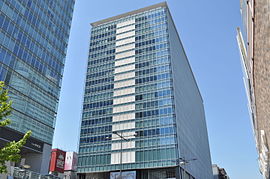Dowa Holdings
 Company headquarters building | |
Native name | DOWAホールディングス株式会社 |
|---|---|
| Type | Public KK |
| TYO: 5714 NAG: 5714 FSE: 5714 Nikkei 225 component | |
| ISIN | JP3638600001 |
| Industry | Nonferrous metals |
| Founded | (September 18, 1884) |
| Founder | Denzaburo Fujita |
| Headquarters | Akihabara UDX building, Sotokanda, Chiyoda-ku, Tokyo, 101-0021 , Japan |
Area served | Worldwide |
Key people | Masao Yamada (President) |
| Products |
|
| Services |
|
| Revenue | |
Number of employees | 6,400 (as of March 31, 2018) |
| Website | Official website |
| Footnotes / references [1][2][3] | |
Dowa Holdings (DOWAホールディングス株式会社, DOWA Hōrudingusu Kabushiki-gaisha) is a Japanese nonferrous metals manufacturer.[3] The company is a component of the Nikkei 225 stock index.[4]
History[]
Fujita-gumi, the forerunner of DOWA,[5] was established by three brothers from Yamaguchi prefecture in 1881. The brothers had personal connections with influential members of the government, so in 1884 they bought the Kosaka mine, from which they expanded their business into various fields, centered on the coal mining business.[6] After the purchase, Fujita-gumi increased its capital and invested heavily in skilled labor and equipment. By 1888 the Kosaka mine became Japan's top producer of silver.[6]
In 1900, an engineer at Kosaka succeeded in extracting copper by accessing the kuroko (black ore — a mixture of copper, zinc and lead) deep in the mine. After that, the Kosaka changed its focus from silver to copper, and in 1907 became Japan's largest top producer.[5]
References[]
- ^ "Corporate Outline". Dowa Holdings. Retrieved February 26, 2016.
- ^ "About the company". Financial Times. Retrieved February 27, 2019.
- ^ Jump up to: a b "Company Profile". Nikkei Asian Review. Nikkei Inc. Retrieved February 27, 2019.
- ^ "Components:Nikkei Stock Average (Nikkei 225)". Nikkei Inc. Retrieved February 26, 2016.
- ^ Jump up to: a b Joanaz de Melo, Cristina; Vaz, Estelita; M. Costa Pinto, Lígia (October 21, 2016). Environmental History in the Making: Volume II: Acting. Springer Science+Business Media. pp. 206–207. ISBN 978-3-319-41139-2.
- ^ Jump up to: a b Hunter, Janet; Storz, Cornelia (June 28, 2006). Institutional and Technological Change in Japan's Economy: Past and Present. Routledge. pp. 32–33. ISBN 978-1-134-20681-0.
External links[]
- Company website (in English)
- "Company history books (Shashi)". Shashi Interest Group. April 2016. Wiki collection of bibliographic works on Dowa Holdings
- Electronics companies of Japan
- Engineering companies of Japan
- Manufacturing companies based in Tokyo
- Mining companies of Japan
- Holding companies of Japan
- Companies listed on the Tokyo Stock Exchange
- Companies listed on the Nagoya Stock Exchange
- Companies listed on the Fukuoka Stock Exchange
- Manufacturing companies established in 1884
- Japanese companies established in 1884
- Holding companies established in 1884
- Japanese company stubs